Business and Business Environment: Tesco Company Analysis Report
VerifiedAdded on 2020/06/05
|12
|3338
|47
Report
AI Summary
This report provides a comprehensive analysis of Tesco's business and its environment. It begins with an introduction to the concept of business and its environment, followed by an examination of different types of organizations, including Tesco, BBC, and Oxfam, along with their legal structures and purposes. The report then delves into the size and scope of these organizations, exploring their human resources, annual turnover, and market share. It further investigates the relationship between organizational structure and functions, highlighting the importance of finance, human resources, marketing, research and development, production, and supply chain management within Tesco. The second part of the report focuses on the impact of the macro environment on businesses, utilizing the PESTLE framework to analyze political, economic, social, technological, environmental, and legal factors affecting Tesco. Finally, it identifies and analyzes Tesco's strengths and weaknesses, exploring the interplay between these internal factors and the external environment, providing a holistic view of the company's position and challenges.
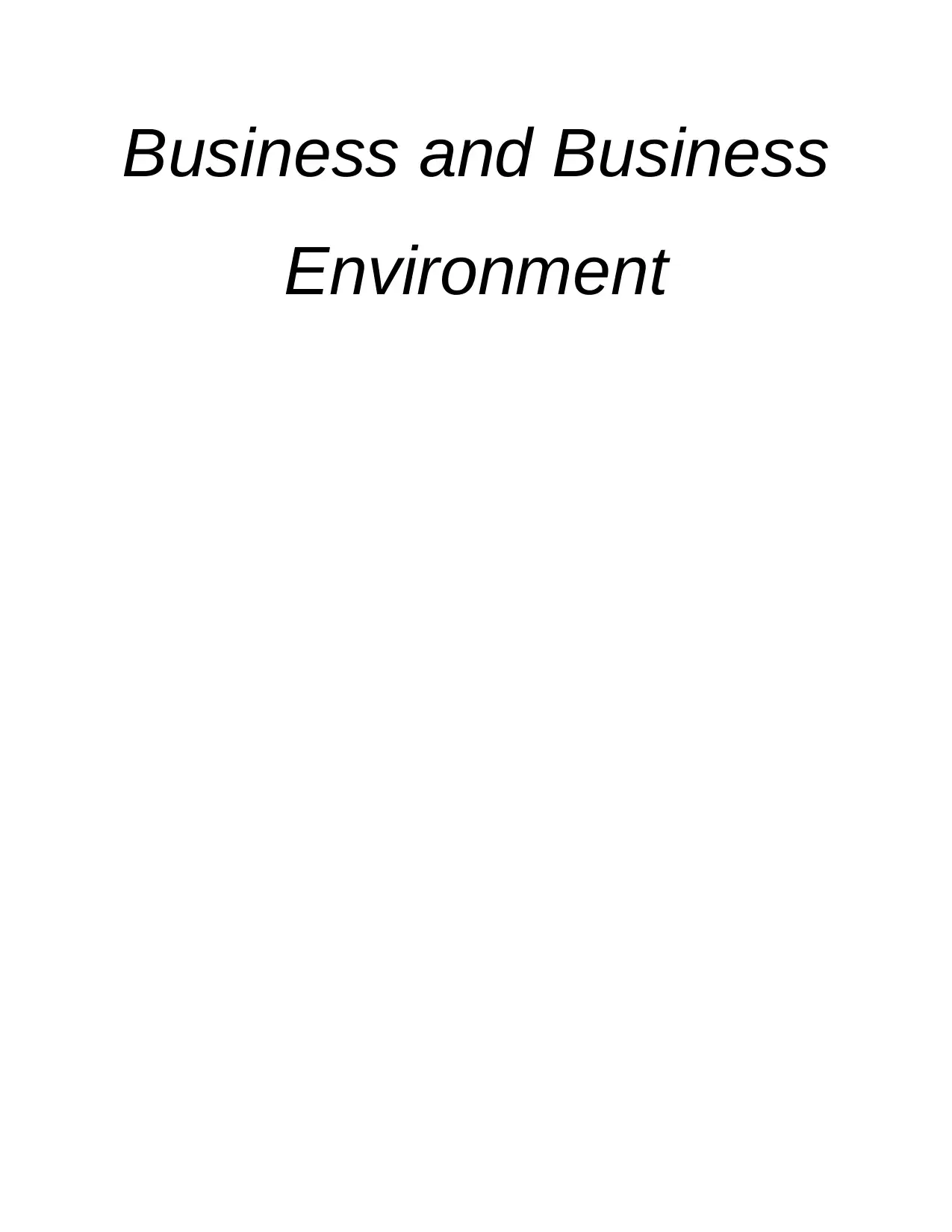
Business and Business
Environment
Environment
Paraphrase This Document
Need a fresh take? Get an instant paraphrase of this document with our AI Paraphraser
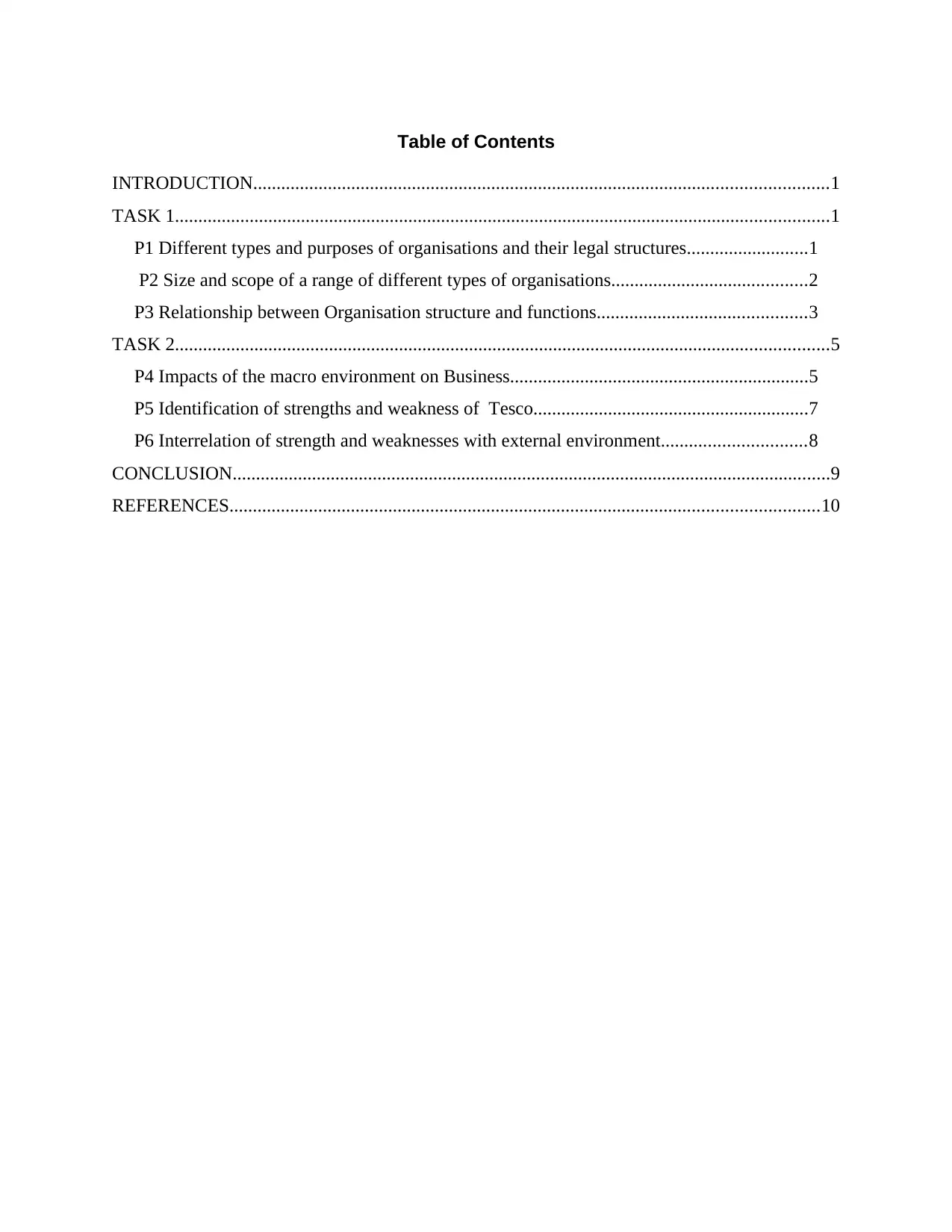
Table of Contents
INTRODUCTION...........................................................................................................................1
TASK 1............................................................................................................................................1
P1 Different types and purposes of organisations and their legal structures..........................1
P2 Size and scope of a range of different types of organisations..........................................2
P3 Relationship between Organisation structure and functions.............................................3
TASK 2............................................................................................................................................5
P4 Impacts of the macro environment on Business................................................................5
P5 Identification of strengths and weakness of Tesco...........................................................7
P6 Interrelation of strength and weaknesses with external environment...............................8
CONCLUSION................................................................................................................................9
REFERENCES..............................................................................................................................10
INTRODUCTION...........................................................................................................................1
TASK 1............................................................................................................................................1
P1 Different types and purposes of organisations and their legal structures..........................1
P2 Size and scope of a range of different types of organisations..........................................2
P3 Relationship between Organisation structure and functions.............................................3
TASK 2............................................................................................................................................5
P4 Impacts of the macro environment on Business................................................................5
P5 Identification of strengths and weakness of Tesco...........................................................7
P6 Interrelation of strength and weaknesses with external environment...............................8
CONCLUSION................................................................................................................................9
REFERENCES..............................................................................................................................10
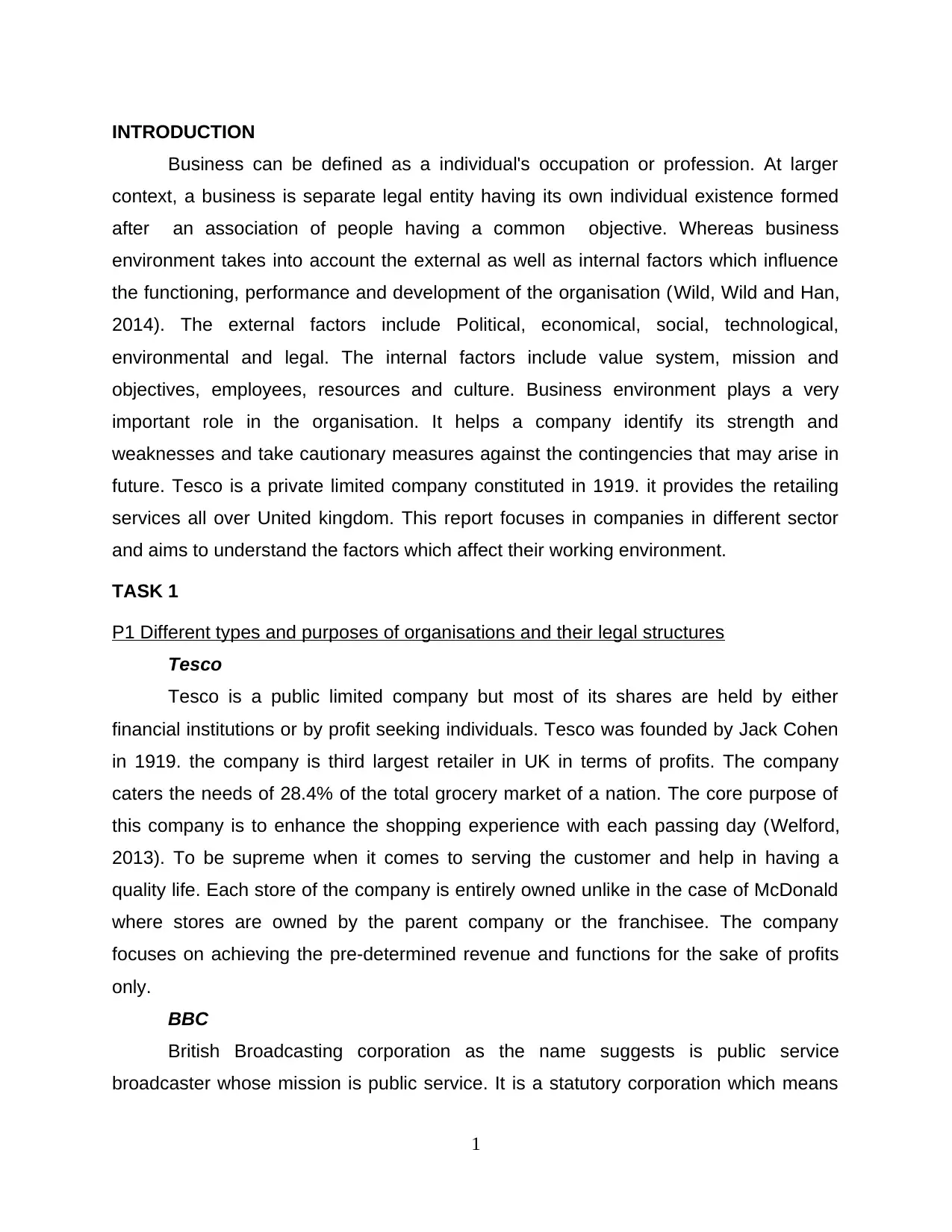
INTRODUCTION
Business can be defined as a individual's occupation or profession. At larger
context, a business is separate legal entity having its own individual existence formed
after an association of people having a common objective. Whereas business
environment takes into account the external as well as internal factors which influence
the functioning, performance and development of the organisation (Wild, Wild and Han,
2014). The external factors include Political, economical, social, technological,
environmental and legal. The internal factors include value system, mission and
objectives, employees, resources and culture. Business environment plays a very
important role in the organisation. It helps a company identify its strength and
weaknesses and take cautionary measures against the contingencies that may arise in
future. Tesco is a private limited company constituted in 1919. it provides the retailing
services all over United kingdom. This report focuses in companies in different sector
and aims to understand the factors which affect their working environment.
TASK 1
P1 Different types and purposes of organisations and their legal structures
Tesco
Tesco is a public limited company but most of its shares are held by either
financial institutions or by profit seeking individuals. Tesco was founded by Jack Cohen
in 1919. the company is third largest retailer in UK in terms of profits. The company
caters the needs of 28.4% of the total grocery market of a nation. The core purpose of
this company is to enhance the shopping experience with each passing day (Welford,
2013). To be supreme when it comes to serving the customer and help in having a
quality life. Each store of the company is entirely owned unlike in the case of McDonald
where stores are owned by the parent company or the franchisee. The company
focuses on achieving the pre-determined revenue and functions for the sake of profits
only.
BBC
British Broadcasting corporation as the name suggests is public service
broadcaster whose mission is public service. It is a statutory corporation which means
1
Business can be defined as a individual's occupation or profession. At larger
context, a business is separate legal entity having its own individual existence formed
after an association of people having a common objective. Whereas business
environment takes into account the external as well as internal factors which influence
the functioning, performance and development of the organisation (Wild, Wild and Han,
2014). The external factors include Political, economical, social, technological,
environmental and legal. The internal factors include value system, mission and
objectives, employees, resources and culture. Business environment plays a very
important role in the organisation. It helps a company identify its strength and
weaknesses and take cautionary measures against the contingencies that may arise in
future. Tesco is a private limited company constituted in 1919. it provides the retailing
services all over United kingdom. This report focuses in companies in different sector
and aims to understand the factors which affect their working environment.
TASK 1
P1 Different types and purposes of organisations and their legal structures
Tesco
Tesco is a public limited company but most of its shares are held by either
financial institutions or by profit seeking individuals. Tesco was founded by Jack Cohen
in 1919. the company is third largest retailer in UK in terms of profits. The company
caters the needs of 28.4% of the total grocery market of a nation. The core purpose of
this company is to enhance the shopping experience with each passing day (Welford,
2013). To be supreme when it comes to serving the customer and help in having a
quality life. Each store of the company is entirely owned unlike in the case of McDonald
where stores are owned by the parent company or the franchisee. The company
focuses on achieving the pre-determined revenue and functions for the sake of profits
only.
BBC
British Broadcasting corporation as the name suggests is public service
broadcaster whose mission is public service. It is a statutory corporation which means
1
⊘ This is a preview!⊘
Do you want full access?
Subscribe today to unlock all pages.

Trusted by 1+ million students worldwide
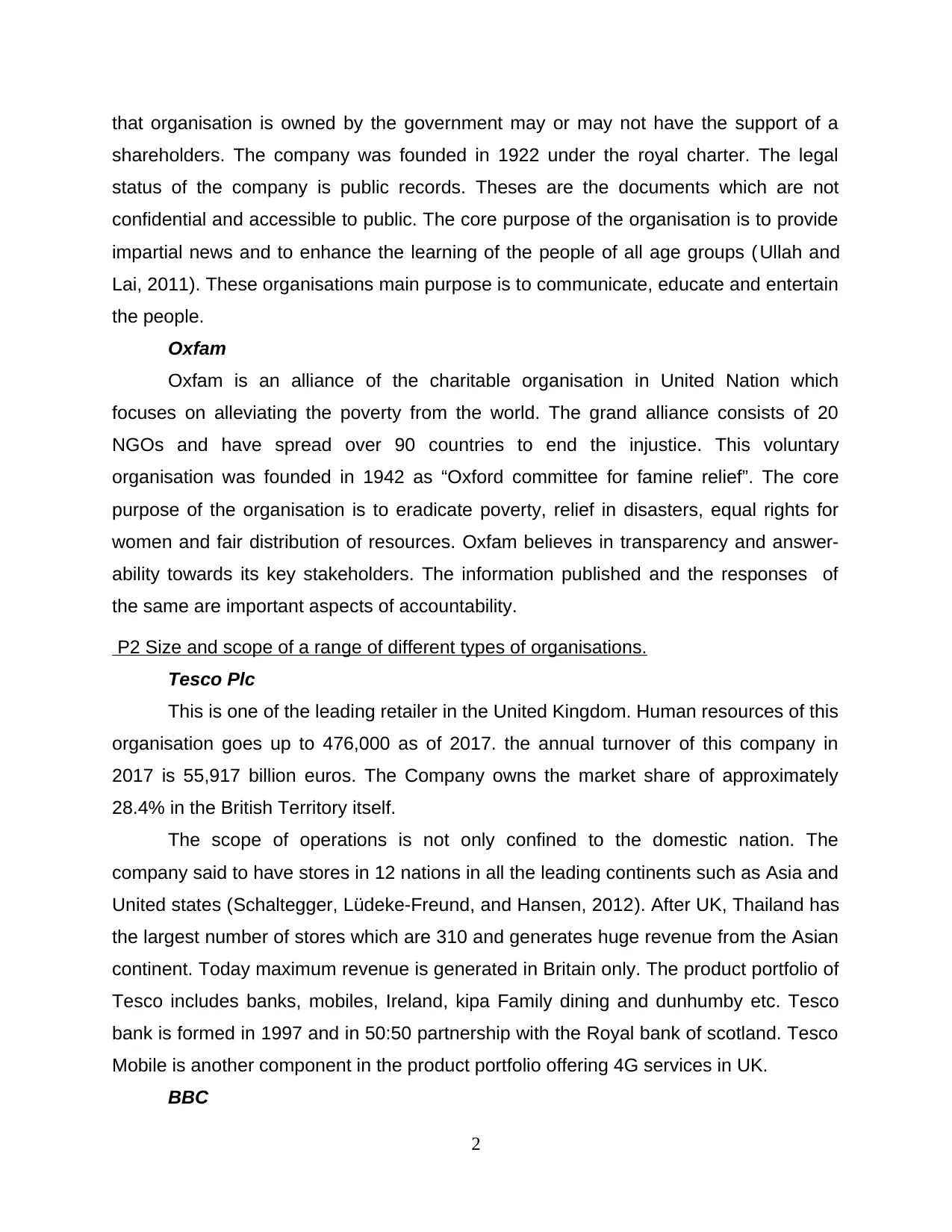
that organisation is owned by the government may or may not have the support of a
shareholders. The company was founded in 1922 under the royal charter. The legal
status of the company is public records. Theses are the documents which are not
confidential and accessible to public. The core purpose of the organisation is to provide
impartial news and to enhance the learning of the people of all age groups ( Ullah and
Lai, 2011). These organisations main purpose is to communicate, educate and entertain
the people.
Oxfam
Oxfam is an alliance of the charitable organisation in United Nation which
focuses on alleviating the poverty from the world. The grand alliance consists of 20
NGOs and have spread over 90 countries to end the injustice. This voluntary
organisation was founded in 1942 as “Oxford committee for famine relief”. The core
purpose of the organisation is to eradicate poverty, relief in disasters, equal rights for
women and fair distribution of resources. Oxfam believes in transparency and answer-
ability towards its key stakeholders. The information published and the responses of
the same are important aspects of accountability.
P2 Size and scope of a range of different types of organisations.
Tesco Plc
This is one of the leading retailer in the United Kingdom. Human resources of this
organisation goes up to 476,000 as of 2017. the annual turnover of this company in
2017 is 55,917 billion euros. The Company owns the market share of approximately
28.4% in the British Territory itself.
The scope of operations is not only confined to the domestic nation. The
company said to have stores in 12 nations in all the leading continents such as Asia and
United states (Schaltegger, Lüdeke-Freund, and Hansen, 2012). After UK, Thailand has
the largest number of stores which are 310 and generates huge revenue from the Asian
continent. Today maximum revenue is generated in Britain only. The product portfolio of
Tesco includes banks, mobiles, Ireland, kipa Family dining and dunhumby etc. Tesco
bank is formed in 1997 and in 50:50 partnership with the Royal bank of scotland. Tesco
Mobile is another component in the product portfolio offering 4G services in UK.
BBC
2
shareholders. The company was founded in 1922 under the royal charter. The legal
status of the company is public records. Theses are the documents which are not
confidential and accessible to public. The core purpose of the organisation is to provide
impartial news and to enhance the learning of the people of all age groups ( Ullah and
Lai, 2011). These organisations main purpose is to communicate, educate and entertain
the people.
Oxfam
Oxfam is an alliance of the charitable organisation in United Nation which
focuses on alleviating the poverty from the world. The grand alliance consists of 20
NGOs and have spread over 90 countries to end the injustice. This voluntary
organisation was founded in 1942 as “Oxford committee for famine relief”. The core
purpose of the organisation is to eradicate poverty, relief in disasters, equal rights for
women and fair distribution of resources. Oxfam believes in transparency and answer-
ability towards its key stakeholders. The information published and the responses of
the same are important aspects of accountability.
P2 Size and scope of a range of different types of organisations.
Tesco Plc
This is one of the leading retailer in the United Kingdom. Human resources of this
organisation goes up to 476,000 as of 2017. the annual turnover of this company in
2017 is 55,917 billion euros. The Company owns the market share of approximately
28.4% in the British Territory itself.
The scope of operations is not only confined to the domestic nation. The
company said to have stores in 12 nations in all the leading continents such as Asia and
United states (Schaltegger, Lüdeke-Freund, and Hansen, 2012). After UK, Thailand has
the largest number of stores which are 310 and generates huge revenue from the Asian
continent. Today maximum revenue is generated in Britain only. The product portfolio of
Tesco includes banks, mobiles, Ireland, kipa Family dining and dunhumby etc. Tesco
bank is formed in 1997 and in 50:50 partnership with the Royal bank of scotland. Tesco
Mobile is another component in the product portfolio offering 4G services in UK.
BBC
2
Paraphrase This Document
Need a fresh take? Get an instant paraphrase of this document with our AI Paraphraser
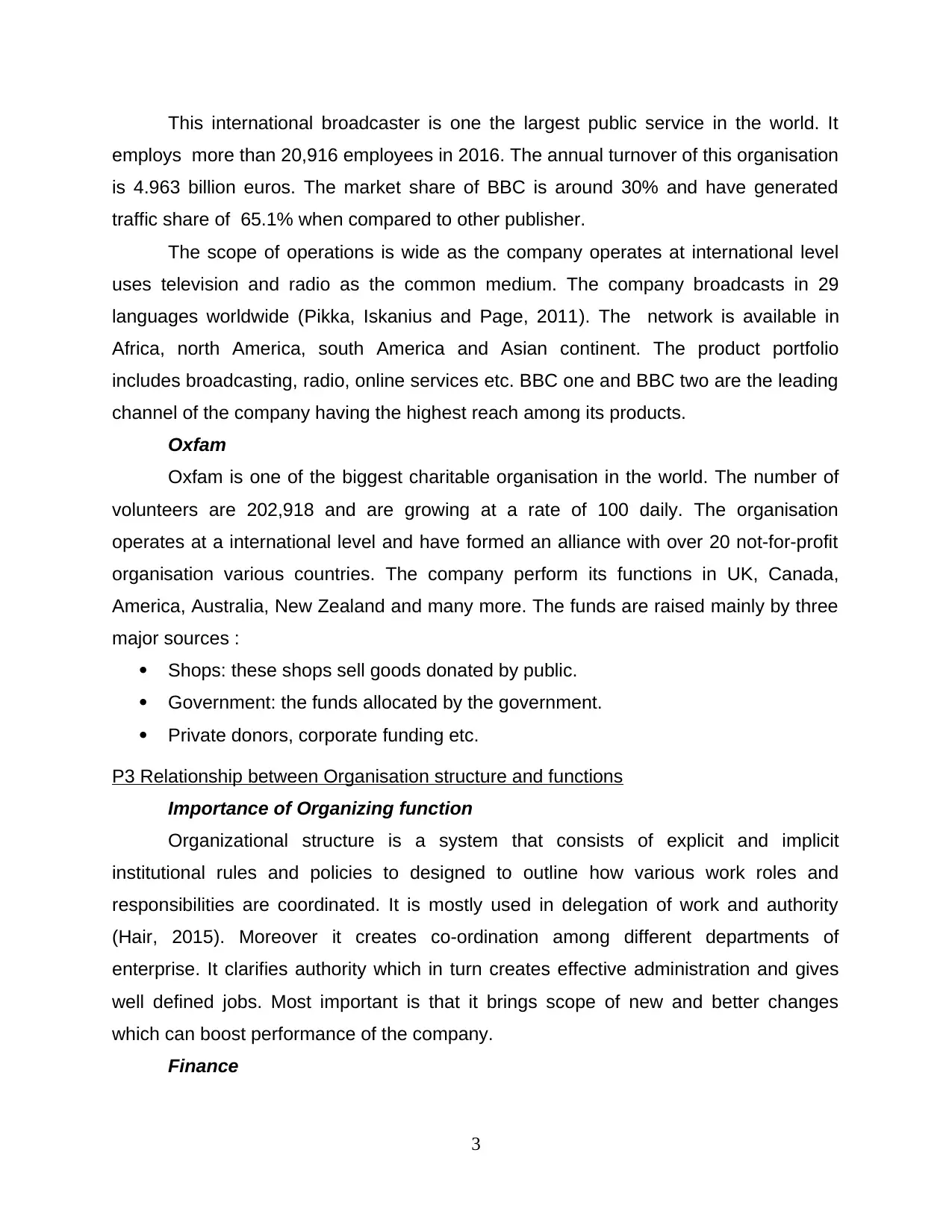
This international broadcaster is one the largest public service in the world. It
employs more than 20,916 employees in 2016. The annual turnover of this organisation
is 4.963 billion euros. The market share of BBC is around 30% and have generated
traffic share of 65.1% when compared to other publisher.
The scope of operations is wide as the company operates at international level
uses television and radio as the common medium. The company broadcasts in 29
languages worldwide (Pikka, Iskanius and Page, 2011). The network is available in
Africa, north America, south America and Asian continent. The product portfolio
includes broadcasting, radio, online services etc. BBC one and BBC two are the leading
channel of the company having the highest reach among its products.
Oxfam
Oxfam is one of the biggest charitable organisation in the world. The number of
volunteers are 202,918 and are growing at a rate of 100 daily. The organisation
operates at a international level and have formed an alliance with over 20 not-for-profit
organisation various countries. The company perform its functions in UK, Canada,
America, Australia, New Zealand and many more. The funds are raised mainly by three
major sources :
Shops: these shops sell goods donated by public.
Government: the funds allocated by the government.
Private donors, corporate funding etc.
P3 Relationship between Organisation structure and functions
Importance of Organizing function
Organizational structure is a system that consists of explicit and implicit
institutional rules and policies to designed to outline how various work roles and
responsibilities are coordinated. It is mostly used in delegation of work and authority
(Hair, 2015). Moreover it creates co-ordination among different departments of
enterprise. It clarifies authority which in turn creates effective administration and gives
well defined jobs. Most important is that it brings scope of new and better changes
which can boost performance of the company.
Finance
3
employs more than 20,916 employees in 2016. The annual turnover of this organisation
is 4.963 billion euros. The market share of BBC is around 30% and have generated
traffic share of 65.1% when compared to other publisher.
The scope of operations is wide as the company operates at international level
uses television and radio as the common medium. The company broadcasts in 29
languages worldwide (Pikka, Iskanius and Page, 2011). The network is available in
Africa, north America, south America and Asian continent. The product portfolio
includes broadcasting, radio, online services etc. BBC one and BBC two are the leading
channel of the company having the highest reach among its products.
Oxfam
Oxfam is one of the biggest charitable organisation in the world. The number of
volunteers are 202,918 and are growing at a rate of 100 daily. The organisation
operates at a international level and have formed an alliance with over 20 not-for-profit
organisation various countries. The company perform its functions in UK, Canada,
America, Australia, New Zealand and many more. The funds are raised mainly by three
major sources :
Shops: these shops sell goods donated by public.
Government: the funds allocated by the government.
Private donors, corporate funding etc.
P3 Relationship between Organisation structure and functions
Importance of Organizing function
Organizational structure is a system that consists of explicit and implicit
institutional rules and policies to designed to outline how various work roles and
responsibilities are coordinated. It is mostly used in delegation of work and authority
(Hair, 2015). Moreover it creates co-ordination among different departments of
enterprise. It clarifies authority which in turn creates effective administration and gives
well defined jobs. Most important is that it brings scope of new and better changes
which can boost performance of the company.
Finance
3
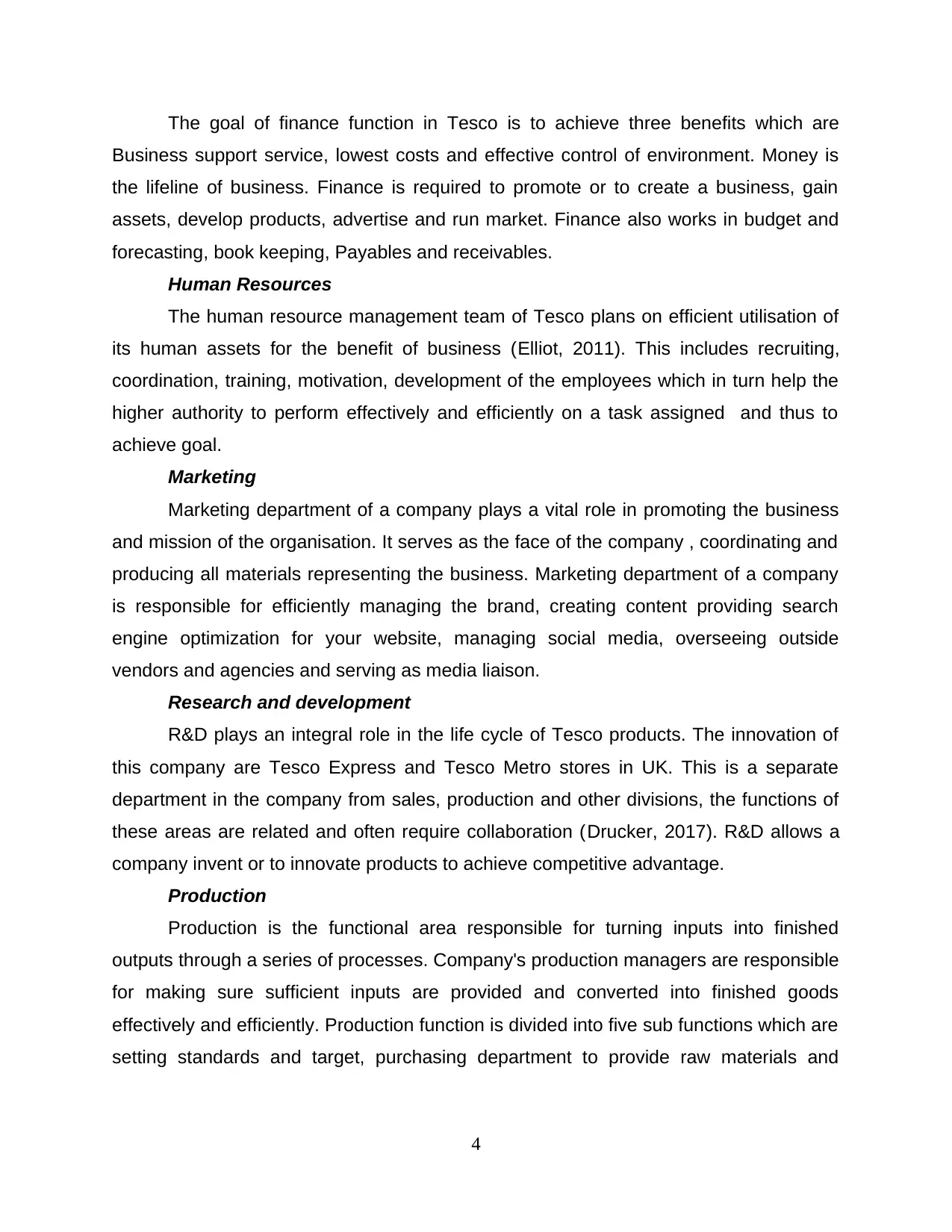
The goal of finance function in Tesco is to achieve three benefits which are
Business support service, lowest costs and effective control of environment. Money is
the lifeline of business. Finance is required to promote or to create a business, gain
assets, develop products, advertise and run market. Finance also works in budget and
forecasting, book keeping, Payables and receivables.
Human Resources
The human resource management team of Tesco plans on efficient utilisation of
its human assets for the benefit of business (Elliot, 2011). This includes recruiting,
coordination, training, motivation, development of the employees which in turn help the
higher authority to perform effectively and efficiently on a task assigned and thus to
achieve goal.
Marketing
Marketing department of a company plays a vital role in promoting the business
and mission of the organisation. It serves as the face of the company , coordinating and
producing all materials representing the business. Marketing department of a company
is responsible for efficiently managing the brand, creating content providing search
engine optimization for your website, managing social media, overseeing outside
vendors and agencies and serving as media liaison.
Research and development
R&D plays an integral role in the life cycle of Tesco products. The innovation of
this company are Tesco Express and Tesco Metro stores in UK. This is a separate
department in the company from sales, production and other divisions, the functions of
these areas are related and often require collaboration (Drucker, 2017). R&D allows a
company invent or to innovate products to achieve competitive advantage.
Production
Production is the functional area responsible for turning inputs into finished
outputs through a series of processes. Company's production managers are responsible
for making sure sufficient inputs are provided and converted into finished goods
effectively and efficiently. Production function is divided into five sub functions which are
setting standards and target, purchasing department to provide raw materials and
4
Business support service, lowest costs and effective control of environment. Money is
the lifeline of business. Finance is required to promote or to create a business, gain
assets, develop products, advertise and run market. Finance also works in budget and
forecasting, book keeping, Payables and receivables.
Human Resources
The human resource management team of Tesco plans on efficient utilisation of
its human assets for the benefit of business (Elliot, 2011). This includes recruiting,
coordination, training, motivation, development of the employees which in turn help the
higher authority to perform effectively and efficiently on a task assigned and thus to
achieve goal.
Marketing
Marketing department of a company plays a vital role in promoting the business
and mission of the organisation. It serves as the face of the company , coordinating and
producing all materials representing the business. Marketing department of a company
is responsible for efficiently managing the brand, creating content providing search
engine optimization for your website, managing social media, overseeing outside
vendors and agencies and serving as media liaison.
Research and development
R&D plays an integral role in the life cycle of Tesco products. The innovation of
this company are Tesco Express and Tesco Metro stores in UK. This is a separate
department in the company from sales, production and other divisions, the functions of
these areas are related and often require collaboration (Drucker, 2017). R&D allows a
company invent or to innovate products to achieve competitive advantage.
Production
Production is the functional area responsible for turning inputs into finished
outputs through a series of processes. Company's production managers are responsible
for making sure sufficient inputs are provided and converted into finished goods
effectively and efficiently. Production function is divided into five sub functions which are
setting standards and target, purchasing department to provide raw materials and
4
⊘ This is a preview!⊘
Do you want full access?
Subscribe today to unlock all pages.

Trusted by 1+ million students worldwide
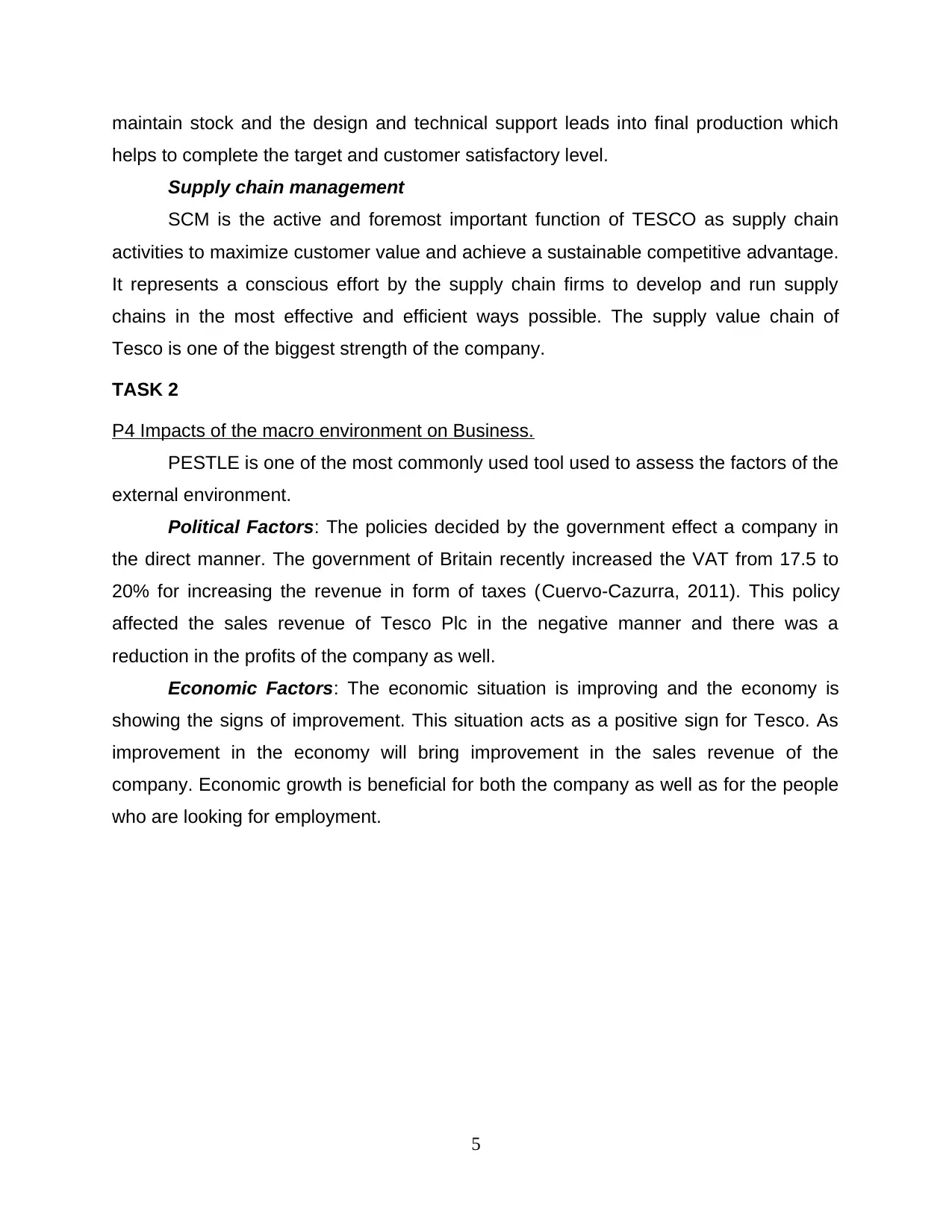
maintain stock and the design and technical support leads into final production which
helps to complete the target and customer satisfactory level.
Supply chain management
SCM is the active and foremost important function of TESCO as supply chain
activities to maximize customer value and achieve a sustainable competitive advantage.
It represents a conscious effort by the supply chain firms to develop and run supply
chains in the most effective and efficient ways possible. The supply value chain of
Tesco is one of the biggest strength of the company.
TASK 2
P4 Impacts of the macro environment on Business.
PESTLE is one of the most commonly used tool used to assess the factors of the
external environment.
Political Factors: The policies decided by the government effect a company in
the direct manner. The government of Britain recently increased the VAT from 17.5 to
20% for increasing the revenue in form of taxes (Cuervo‐Cazurra, 2011). This policy
affected the sales revenue of Tesco Plc in the negative manner and there was a
reduction in the profits of the company as well.
Economic Factors: The economic situation is improving and the economy is
showing the signs of improvement. This situation acts as a positive sign for Tesco. As
improvement in the economy will bring improvement in the sales revenue of the
company. Economic growth is beneficial for both the company as well as for the people
who are looking for employment.
5
helps to complete the target and customer satisfactory level.
Supply chain management
SCM is the active and foremost important function of TESCO as supply chain
activities to maximize customer value and achieve a sustainable competitive advantage.
It represents a conscious effort by the supply chain firms to develop and run supply
chains in the most effective and efficient ways possible. The supply value chain of
Tesco is one of the biggest strength of the company.
TASK 2
P4 Impacts of the macro environment on Business.
PESTLE is one of the most commonly used tool used to assess the factors of the
external environment.
Political Factors: The policies decided by the government effect a company in
the direct manner. The government of Britain recently increased the VAT from 17.5 to
20% for increasing the revenue in form of taxes (Cuervo‐Cazurra, 2011). This policy
affected the sales revenue of Tesco Plc in the negative manner and there was a
reduction in the profits of the company as well.
Economic Factors: The economic situation is improving and the economy is
showing the signs of improvement. This situation acts as a positive sign for Tesco. As
improvement in the economy will bring improvement in the sales revenue of the
company. Economic growth is beneficial for both the company as well as for the people
who are looking for employment.
5
Paraphrase This Document
Need a fresh take? Get an instant paraphrase of this document with our AI Paraphraser
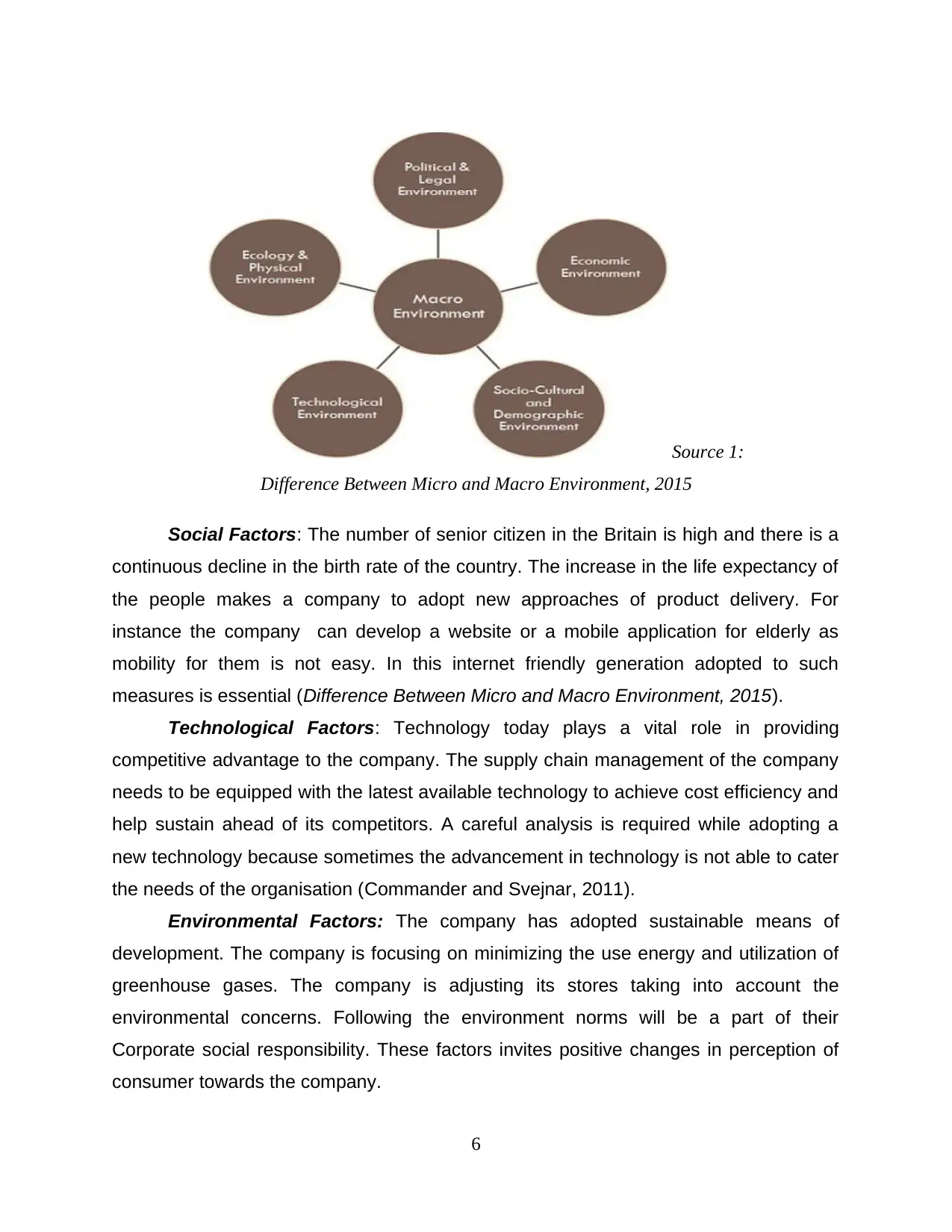
Social Factors: The number of senior citizen in the Britain is high and there is a
continuous decline in the birth rate of the country. The increase in the life expectancy of
the people makes a company to adopt new approaches of product delivery. For
instance the company can develop a website or a mobile application for elderly as
mobility for them is not easy. In this internet friendly generation adopted to such
measures is essential (Difference Between Micro and Macro Environment, 2015).
Technological Factors: Technology today plays a vital role in providing
competitive advantage to the company. The supply chain management of the company
needs to be equipped with the latest available technology to achieve cost efficiency and
help sustain ahead of its competitors. A careful analysis is required while adopting a
new technology because sometimes the advancement in technology is not able to cater
the needs of the organisation (Commander and Svejnar, 2011).
Environmental Factors: The company has adopted sustainable means of
development. The company is focusing on minimizing the use energy and utilization of
greenhouse gases. The company is adjusting its stores taking into account the
environmental concerns. Following the environment norms will be a part of their
Corporate social responsibility. These factors invites positive changes in perception of
consumer towards the company.
6
Source 1:
Difference Between Micro and Macro Environment, 2015
continuous decline in the birth rate of the country. The increase in the life expectancy of
the people makes a company to adopt new approaches of product delivery. For
instance the company can develop a website or a mobile application for elderly as
mobility for them is not easy. In this internet friendly generation adopted to such
measures is essential (Difference Between Micro and Macro Environment, 2015).
Technological Factors: Technology today plays a vital role in providing
competitive advantage to the company. The supply chain management of the company
needs to be equipped with the latest available technology to achieve cost efficiency and
help sustain ahead of its competitors. A careful analysis is required while adopting a
new technology because sometimes the advancement in technology is not able to cater
the needs of the organisation (Commander and Svejnar, 2011).
Environmental Factors: The company has adopted sustainable means of
development. The company is focusing on minimizing the use energy and utilization of
greenhouse gases. The company is adjusting its stores taking into account the
environmental concerns. Following the environment norms will be a part of their
Corporate social responsibility. These factors invites positive changes in perception of
consumer towards the company.
6
Source 1:
Difference Between Micro and Macro Environment, 2015
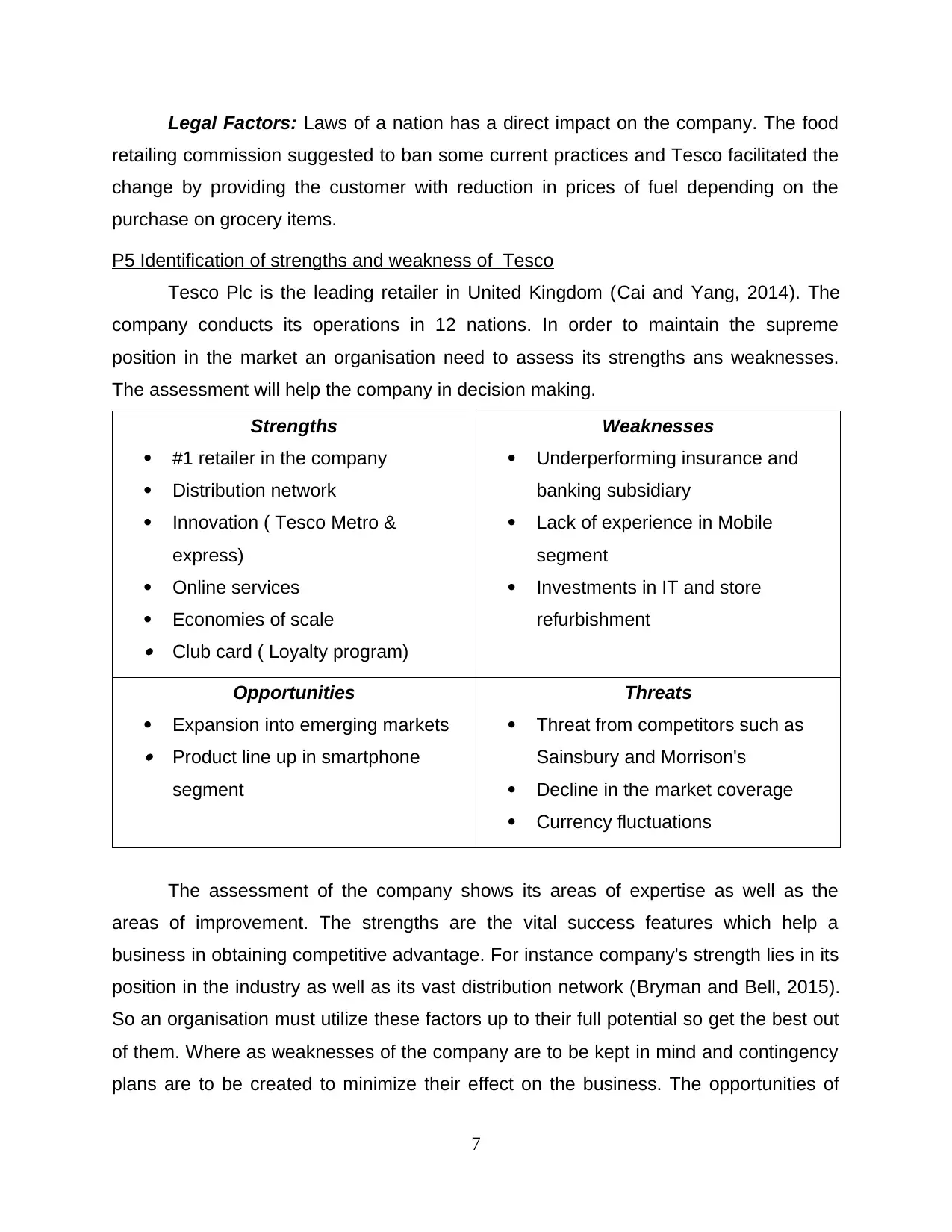
Legal Factors: Laws of a nation has a direct impact on the company. The food
retailing commission suggested to ban some current practices and Tesco facilitated the
change by providing the customer with reduction in prices of fuel depending on the
purchase on grocery items.
P5 Identification of strengths and weakness of Tesco
Tesco Plc is the leading retailer in United Kingdom (Cai and Yang, 2014). The
company conducts its operations in 12 nations. In order to maintain the supreme
position in the market an organisation need to assess its strengths ans weaknesses.
The assessment will help the company in decision making.
Strengths
#1 retailer in the company
Distribution network
Innovation ( Tesco Metro &
express)
Online services
Economies of scale Club card ( Loyalty program)
Weaknesses
Underperforming insurance and
banking subsidiary
Lack of experience in Mobile
segment
Investments in IT and store
refurbishment
Opportunities
Expansion into emerging markets Product line up in smartphone
segment
Threats
Threat from competitors such as
Sainsbury and Morrison's
Decline in the market coverage
Currency fluctuations
The assessment of the company shows its areas of expertise as well as the
areas of improvement. The strengths are the vital success features which help a
business in obtaining competitive advantage. For instance company's strength lies in its
position in the industry as well as its vast distribution network (Bryman and Bell, 2015).
So an organisation must utilize these factors up to their full potential so get the best out
of them. Where as weaknesses of the company are to be kept in mind and contingency
plans are to be created to minimize their effect on the business. The opportunities of
7
retailing commission suggested to ban some current practices and Tesco facilitated the
change by providing the customer with reduction in prices of fuel depending on the
purchase on grocery items.
P5 Identification of strengths and weakness of Tesco
Tesco Plc is the leading retailer in United Kingdom (Cai and Yang, 2014). The
company conducts its operations in 12 nations. In order to maintain the supreme
position in the market an organisation need to assess its strengths ans weaknesses.
The assessment will help the company in decision making.
Strengths
#1 retailer in the company
Distribution network
Innovation ( Tesco Metro &
express)
Online services
Economies of scale Club card ( Loyalty program)
Weaknesses
Underperforming insurance and
banking subsidiary
Lack of experience in Mobile
segment
Investments in IT and store
refurbishment
Opportunities
Expansion into emerging markets Product line up in smartphone
segment
Threats
Threat from competitors such as
Sainsbury and Morrison's
Decline in the market coverage
Currency fluctuations
The assessment of the company shows its areas of expertise as well as the
areas of improvement. The strengths are the vital success features which help a
business in obtaining competitive advantage. For instance company's strength lies in its
position in the industry as well as its vast distribution network (Bryman and Bell, 2015).
So an organisation must utilize these factors up to their full potential so get the best out
of them. Where as weaknesses of the company are to be kept in mind and contingency
plans are to be created to minimize their effect on the business. The opportunities of
7
⊘ This is a preview!⊘
Do you want full access?
Subscribe today to unlock all pages.

Trusted by 1+ million students worldwide
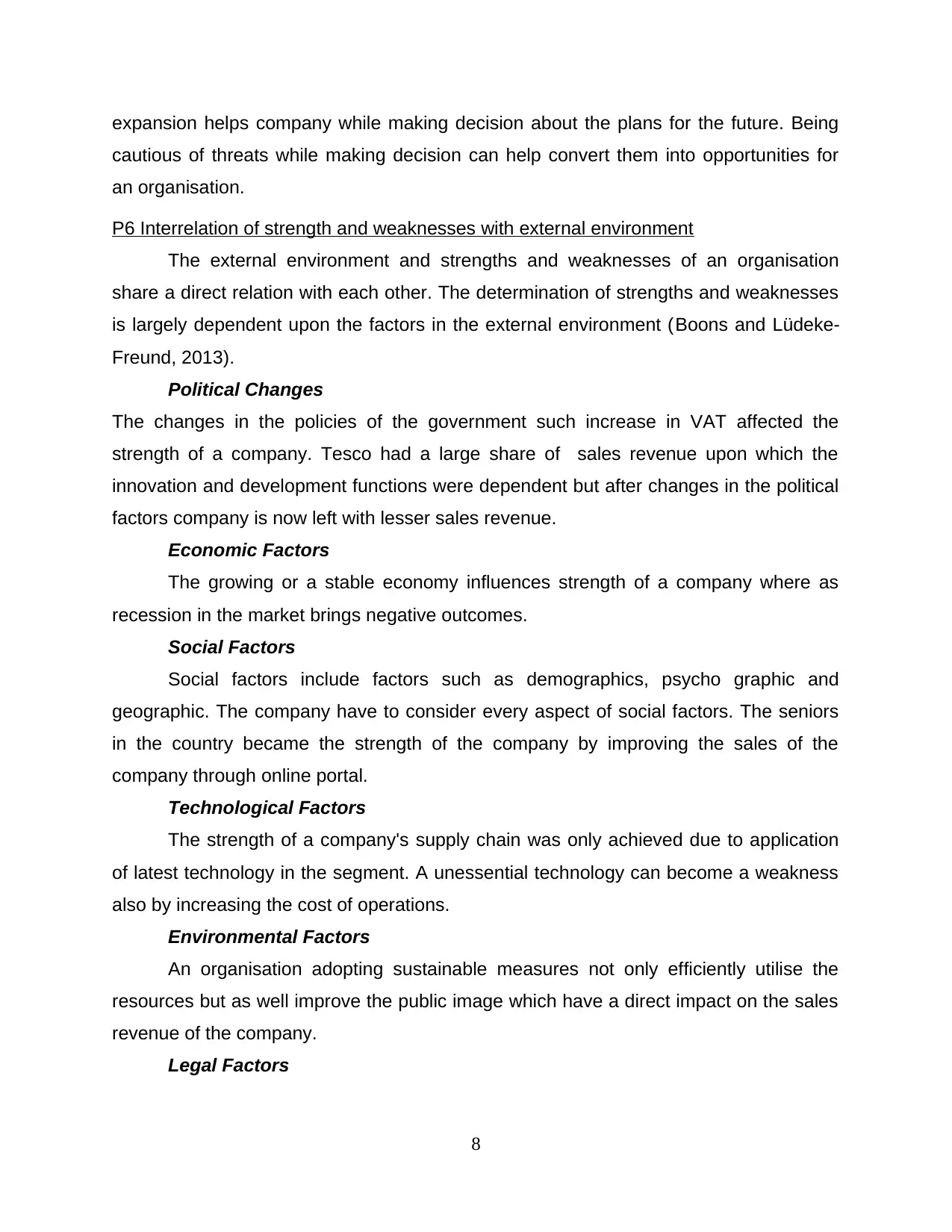
expansion helps company while making decision about the plans for the future. Being
cautious of threats while making decision can help convert them into opportunities for
an organisation.
P6 Interrelation of strength and weaknesses with external environment
The external environment and strengths and weaknesses of an organisation
share a direct relation with each other. The determination of strengths and weaknesses
is largely dependent upon the factors in the external environment (Boons and Lüdeke-
Freund, 2013).
Political Changes
The changes in the policies of the government such increase in VAT affected the
strength of a company. Tesco had a large share of sales revenue upon which the
innovation and development functions were dependent but after changes in the political
factors company is now left with lesser sales revenue.
Economic Factors
The growing or a stable economy influences strength of a company where as
recession in the market brings negative outcomes.
Social Factors
Social factors include factors such as demographics, psycho graphic and
geographic. The company have to consider every aspect of social factors. The seniors
in the country became the strength of the company by improving the sales of the
company through online portal.
Technological Factors
The strength of a company's supply chain was only achieved due to application
of latest technology in the segment. A unessential technology can become a weakness
also by increasing the cost of operations.
Environmental Factors
An organisation adopting sustainable measures not only efficiently utilise the
resources but as well improve the public image which have a direct impact on the sales
revenue of the company.
Legal Factors
8
cautious of threats while making decision can help convert them into opportunities for
an organisation.
P6 Interrelation of strength and weaknesses with external environment
The external environment and strengths and weaknesses of an organisation
share a direct relation with each other. The determination of strengths and weaknesses
is largely dependent upon the factors in the external environment (Boons and Lüdeke-
Freund, 2013).
Political Changes
The changes in the policies of the government such increase in VAT affected the
strength of a company. Tesco had a large share of sales revenue upon which the
innovation and development functions were dependent but after changes in the political
factors company is now left with lesser sales revenue.
Economic Factors
The growing or a stable economy influences strength of a company where as
recession in the market brings negative outcomes.
Social Factors
Social factors include factors such as demographics, psycho graphic and
geographic. The company have to consider every aspect of social factors. The seniors
in the country became the strength of the company by improving the sales of the
company through online portal.
Technological Factors
The strength of a company's supply chain was only achieved due to application
of latest technology in the segment. A unessential technology can become a weakness
also by increasing the cost of operations.
Environmental Factors
An organisation adopting sustainable measures not only efficiently utilise the
resources but as well improve the public image which have a direct impact on the sales
revenue of the company.
Legal Factors
8
Paraphrase This Document
Need a fresh take? Get an instant paraphrase of this document with our AI Paraphraser
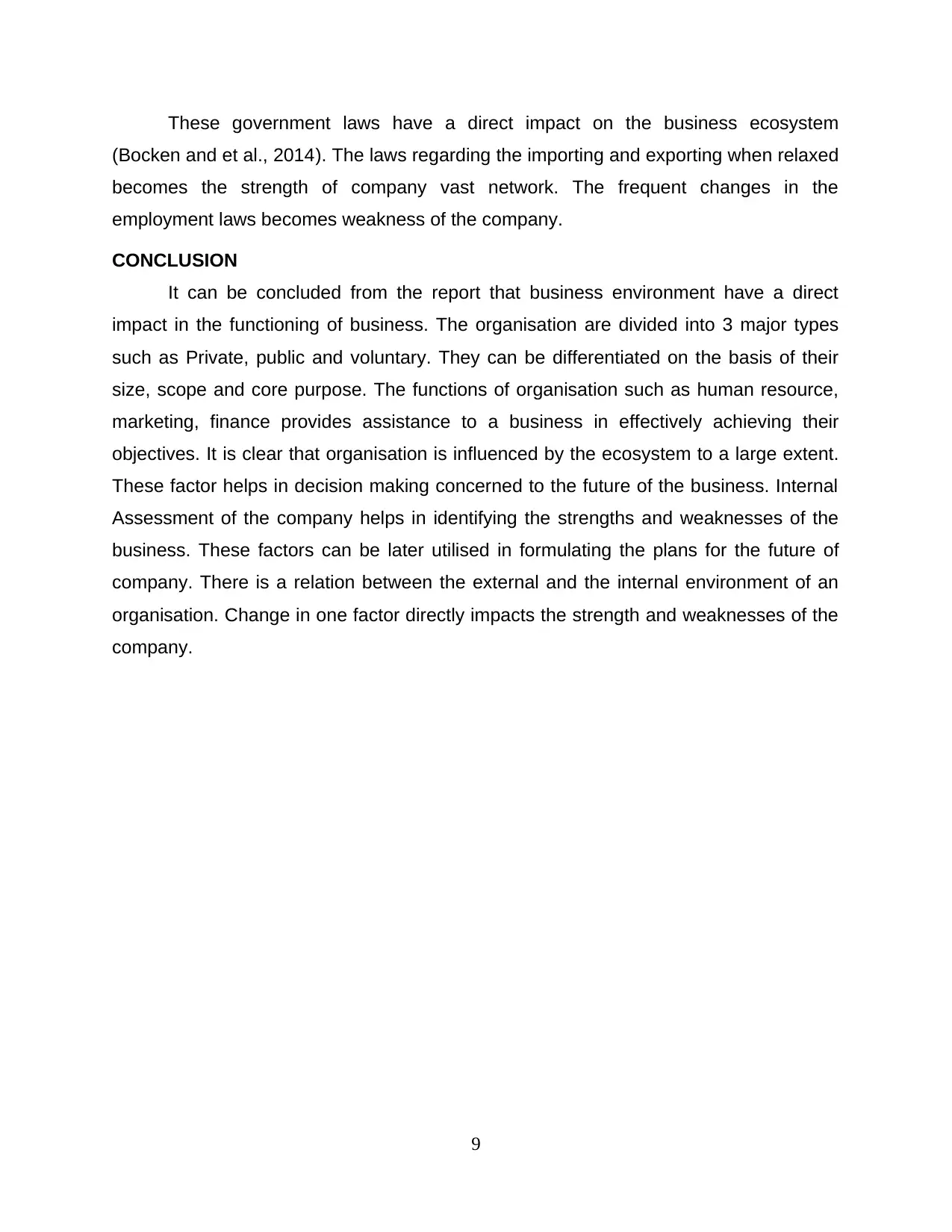
These government laws have a direct impact on the business ecosystem
(Bocken and et al., 2014). The laws regarding the importing and exporting when relaxed
becomes the strength of company vast network. The frequent changes in the
employment laws becomes weakness of the company.
CONCLUSION
It can be concluded from the report that business environment have a direct
impact in the functioning of business. The organisation are divided into 3 major types
such as Private, public and voluntary. They can be differentiated on the basis of their
size, scope and core purpose. The functions of organisation such as human resource,
marketing, finance provides assistance to a business in effectively achieving their
objectives. It is clear that organisation is influenced by the ecosystem to a large extent.
These factor helps in decision making concerned to the future of the business. Internal
Assessment of the company helps in identifying the strengths and weaknesses of the
business. These factors can be later utilised in formulating the plans for the future of
company. There is a relation between the external and the internal environment of an
organisation. Change in one factor directly impacts the strength and weaknesses of the
company.
9
(Bocken and et al., 2014). The laws regarding the importing and exporting when relaxed
becomes the strength of company vast network. The frequent changes in the
employment laws becomes weakness of the company.
CONCLUSION
It can be concluded from the report that business environment have a direct
impact in the functioning of business. The organisation are divided into 3 major types
such as Private, public and voluntary. They can be differentiated on the basis of their
size, scope and core purpose. The functions of organisation such as human resource,
marketing, finance provides assistance to a business in effectively achieving their
objectives. It is clear that organisation is influenced by the ecosystem to a large extent.
These factor helps in decision making concerned to the future of the business. Internal
Assessment of the company helps in identifying the strengths and weaknesses of the
business. These factors can be later utilised in formulating the plans for the future of
company. There is a relation between the external and the internal environment of an
organisation. Change in one factor directly impacts the strength and weaknesses of the
company.
9
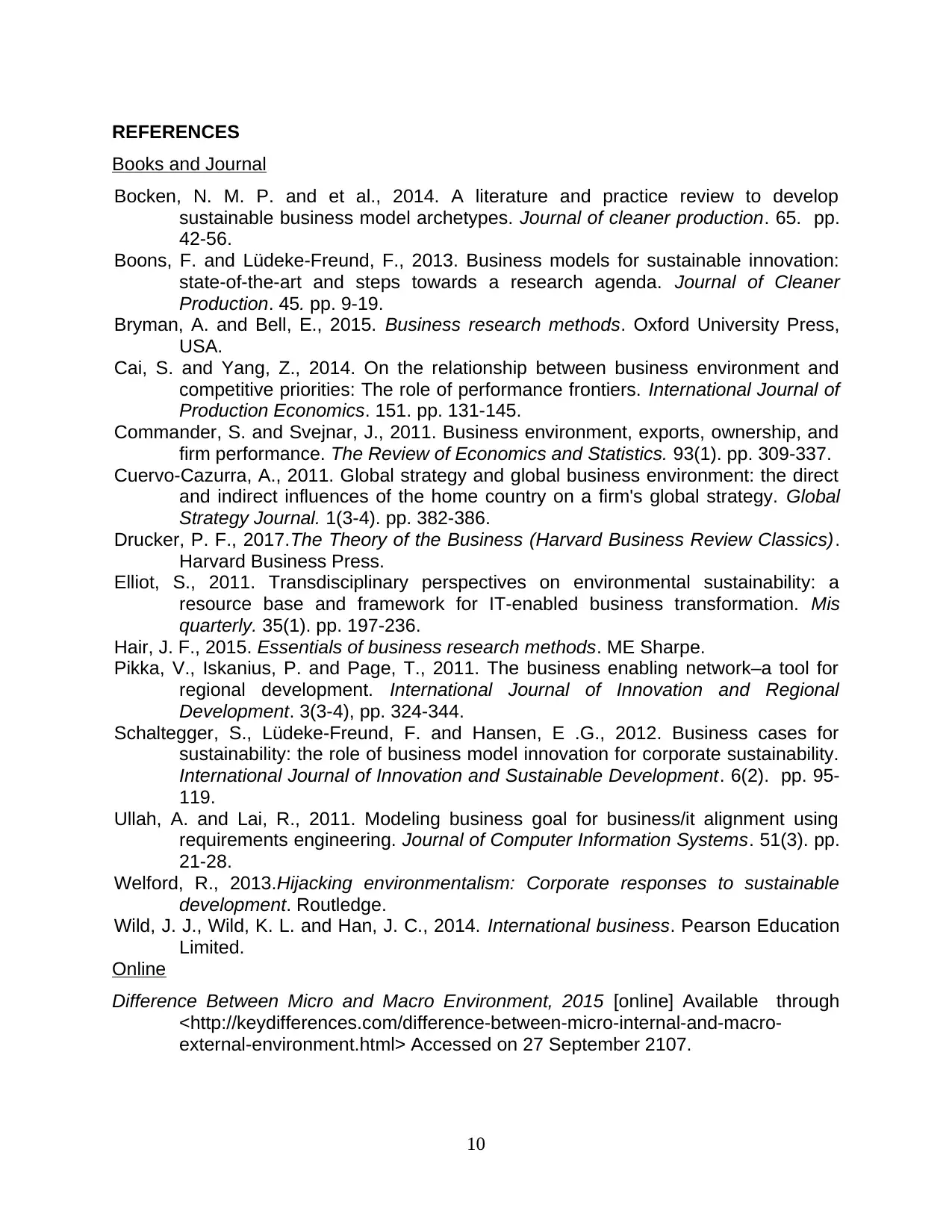
REFERENCES
Books and Journal
Bocken, N. M. P. and et al., 2014. A literature and practice review to develop
sustainable business model archetypes. Journal of cleaner production. 65. pp.
42-56.
Boons, F. and Lüdeke-Freund, F., 2013. Business models for sustainable innovation:
state-of-the-art and steps towards a research agenda. Journal of Cleaner
Production. 45. pp. 9-19.
Bryman, A. and Bell, E., 2015. Business research methods. Oxford University Press,
USA.
Cai, S. and Yang, Z., 2014. On the relationship between business environment and
competitive priorities: The role of performance frontiers. International Journal of
Production Economics. 151. pp. 131-145.
Commander, S. and Svejnar, J., 2011. Business environment, exports, ownership, and
firm performance. The Review of Economics and Statistics. 93(1). pp. 309-337.
Cuervo‐Cazurra, A., 2011. Global strategy and global business environment: the direct
and indirect influences of the home country on a firm's global strategy. Global
Strategy Journal. 1(3‐4). pp. 382-386.
Drucker, P. F., 2017.The Theory of the Business (Harvard Business Review Classics).
Harvard Business Press.
Elliot, S., 2011. Transdisciplinary perspectives on environmental sustainability: a
resource base and framework for IT-enabled business transformation. Mis
quarterly. 35(1). pp. 197-236.
Hair, J. F., 2015. Essentials of business research methods. ME Sharpe.
Pikka, V., Iskanius, P. and Page, T., 2011. The business enabling network–a tool for
regional development. International Journal of Innovation and Regional
Development. 3(3-4), pp. 324-344.
Schaltegger, S., Lüdeke-Freund, F. and Hansen, E .G., 2012. Business cases for
sustainability: the role of business model innovation for corporate sustainability.
International Journal of Innovation and Sustainable Development. 6(2). pp. 95-
119.
Ullah, A. and Lai, R., 2011. Modeling business goal for business/it alignment using
requirements engineering. Journal of Computer Information Systems. 51(3). pp.
21-28.
Welford, R., 2013.Hijacking environmentalism: Corporate responses to sustainable
development. Routledge.
Wild, J. J., Wild, K. L. and Han, J. C., 2014. International business. Pearson Education
Limited.
Online
Difference Between Micro and Macro Environment, 2015 [online] Available through
<http://keydifferences.com/difference-between-micro-internal-and-macro-
external-environment.html> Accessed on 27 September 2107.
10
Books and Journal
Bocken, N. M. P. and et al., 2014. A literature and practice review to develop
sustainable business model archetypes. Journal of cleaner production. 65. pp.
42-56.
Boons, F. and Lüdeke-Freund, F., 2013. Business models for sustainable innovation:
state-of-the-art and steps towards a research agenda. Journal of Cleaner
Production. 45. pp. 9-19.
Bryman, A. and Bell, E., 2015. Business research methods. Oxford University Press,
USA.
Cai, S. and Yang, Z., 2014. On the relationship between business environment and
competitive priorities: The role of performance frontiers. International Journal of
Production Economics. 151. pp. 131-145.
Commander, S. and Svejnar, J., 2011. Business environment, exports, ownership, and
firm performance. The Review of Economics and Statistics. 93(1). pp. 309-337.
Cuervo‐Cazurra, A., 2011. Global strategy and global business environment: the direct
and indirect influences of the home country on a firm's global strategy. Global
Strategy Journal. 1(3‐4). pp. 382-386.
Drucker, P. F., 2017.The Theory of the Business (Harvard Business Review Classics).
Harvard Business Press.
Elliot, S., 2011. Transdisciplinary perspectives on environmental sustainability: a
resource base and framework for IT-enabled business transformation. Mis
quarterly. 35(1). pp. 197-236.
Hair, J. F., 2015. Essentials of business research methods. ME Sharpe.
Pikka, V., Iskanius, P. and Page, T., 2011. The business enabling network–a tool for
regional development. International Journal of Innovation and Regional
Development. 3(3-4), pp. 324-344.
Schaltegger, S., Lüdeke-Freund, F. and Hansen, E .G., 2012. Business cases for
sustainability: the role of business model innovation for corporate sustainability.
International Journal of Innovation and Sustainable Development. 6(2). pp. 95-
119.
Ullah, A. and Lai, R., 2011. Modeling business goal for business/it alignment using
requirements engineering. Journal of Computer Information Systems. 51(3). pp.
21-28.
Welford, R., 2013.Hijacking environmentalism: Corporate responses to sustainable
development. Routledge.
Wild, J. J., Wild, K. L. and Han, J. C., 2014. International business. Pearson Education
Limited.
Online
Difference Between Micro and Macro Environment, 2015 [online] Available through
<http://keydifferences.com/difference-between-micro-internal-and-macro-
external-environment.html> Accessed on 27 September 2107.
10
⊘ This is a preview!⊘
Do you want full access?
Subscribe today to unlock all pages.

Trusted by 1+ million students worldwide
1 out of 12
Related Documents
Your All-in-One AI-Powered Toolkit for Academic Success.
+13062052269
info@desklib.com
Available 24*7 on WhatsApp / Email
![[object Object]](/_next/static/media/star-bottom.7253800d.svg)
Unlock your academic potential
Copyright © 2020–2025 A2Z Services. All Rights Reserved. Developed and managed by ZUCOL.





